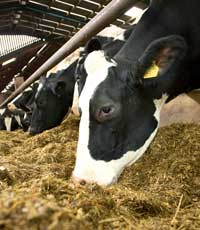Uncertainty in feed market despite movement

There are movements on the feed markets, but still plenty of uncertainty, reports KW’s Colin Shepherd.
Recent fund activity has produced some significant market falls in recent weeks, with a number of key investors selling off commodity contracts following concerns the market had peaked.
At the time of writing, soyabean meal, for example, was trading in the mid-to-high £280s/t for contracts right through until April 2012.
Compared to a spot market that spent most of its time above £300/t last winter, it is reasonable value and worth considering for perhaps 20-30% of requirements to guard against future price increases. However, at present there seems to be just as much chance that prices might drop further, rather than return immediately to previous highs.
It all depends on how long the fund buyers continue to exit the markets, and that will probably stop the moment commodity values show signs of a rebound. Keep in very close contact with your feed supplier, and look to make the most of this sizeable dip in the market as it develops over the coming weeks. But it’s also important to remember that global supply and demand remain finely balanced.
The drop in soyabean meal prices was helped by rumours of more corn acreage in the US switching to soyabeans (increased supply) and reduced US soyabean export demand. Interest rate rises in China may reduce economic growth, raising concerns that feed commodity imports may be affected (reduced demand).
But China is still currently importing about 4m tonnes of soyabeans each month from South America, where a good harvest and weaker currency has produced a more competitive export price than in the US. If the US dollar continues to fall, this situation may change, and any rise in US export demand could be the trigger needed for markets to rise once again.
It’s worth noting that US soyabean planting has only just begun, so remains under threat from potential adverse weather in the coming months. Corn plantings are already well behind (20% planted compared to 60% at this time last year) due to heavy rains – a driving factor behind the move to increased soyabean plantings – so weather news will have a heavy impact on market movements from now on.
In contrast to the major corn-growing areas, the southern plains of North America are suffering a dry spell that could threaten wheat yields. Canadian oilseed rape (canola) plantings look likely to be delayed by heavy snowpack.
Good rains are also needed across most of northern Europe if cereal and oilseed rape crops are not to be adversely affected. With new crop wheat currently at around £170/t, there’s clearly room for prices to fall if the rains do come, and with the Ukraine set to re-enter the export market this year, there appears to be some potential for prices to come back further.
Caution is still needed, though, as China still appears to have a drought problem, and there are suggestions that Chinese plantings this year are favouring corn at the expense of wheat, soyabean and rapemeal. Whether this means that more of these commodities will need to be imported remains to be seen, but the increases in US plantings reported earlier in the year certainly aren’t sufficient to cover the rumoured change in Chinese cropping.
In the UK, some feeds also remain in short supply. Although moist feeds like brewers’ grains have become more available following turnout, demand is still likely to outstrip supply at some point during the summer, particularly if an extended dry period causes grass growth to falter.
Two current buying opportunities are wheatfeed and rapemeal. Old crop rapemeal is currently trading at about £160-170/t as crushers are forced to sell material that’s not been sold forward. Act now to book rapemeal needed before new crop material becomes available, as any drop in the value of the pound could produce new export opportunities, quickly eliminating the current surplus.
Wheatfeed at £132/t (current price for meal or pellets ex-mill) is a great deal compared to other energy feeds, while molasses-based liquid feeds continue to offer good value – molasses prices aren’t affected by the same commodity markets as many traditional feeds. And don’t forget maize gluten, which at the moment is around £10/t below its true value compared to other feeds, and definitely worth considering.
feedwatch
